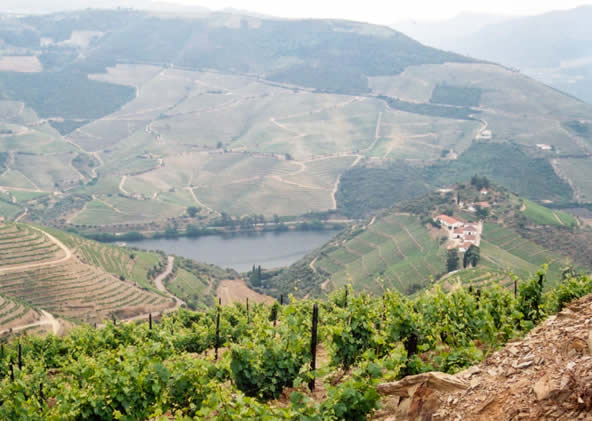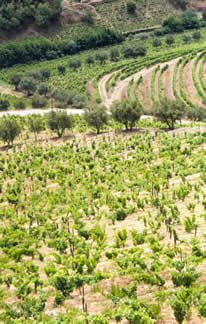|
The
wineanorak's guide to
PORTUGAL'S WINE
REGIONS

In looking at Portugal’s wine regions, it’s helpful to
split the country in two, by drawing a line about a third of the way
down. This separates the northern regions of the Douro, Dão and
Bairrada, and the central and southern regions of the Alentejo,
Ribatejo and Estremadura. As a useful generalization, the future for
the northern regions lies in focusing on high-quality, top-end
‘terroir’ wines, while the strength of the southern and central
regions is their ability to produce accessible, full flavoured red
wines in large quantities and at affordable prices: new world-style
wines with a Portuguese twist.
The Douro
In a relatively short period of time the Douro has established
itself as Portugal’s premium wine region. It’s hard to overstate
the scale and pace of change that is currently taking place in this
most spectacular of wine regions. The steeply terraced vineyards
contain some wonderful terroirs, but because of the economic dominance
of the Port trade it is only recently that these have been widely
exploited to produce premium wines. Table wine has always been made
here but, with a couple of notable exceptions (the legendary Barca
Velha and more recently Duas Quintas Reserva and Quinta do Côtto
Grande Eschola), it has been grim stuff, usually badly made from low
quality grapes that were surplus to the requirements of Port
producers.
 Various
factors have conspired to change this situation. Most importantly, a
critical mass of like-minded winemakers has emerged, passionate about
making the very best wines that these remarkable terroirs are capable
of. Various
factors have conspired to change this situation. Most importantly, a
critical mass of like-minded winemakers has emerged, passionate about
making the very best wines that these remarkable terroirs are capable
of.
In particular, Dirk Niepoort has been a key player in
recent developments in the region. As well as producing some
brilliantly expressive Douro wines himself, he’s been acting as a
catalyst by encouraging the leading wine producers to get together and
spur each other on to greater things. There’s still very much of a
pioneering air here, with many of the new premium wines in only their
first or second vintage. One encouraging trend is that while the
quality is uniformly pretty high, there are a variety of different
styles emerging, all of which still hold true to their Douro origins.
Significant names here include Niepoort’s Redoma, Batuta and Charme,
newcomers Poeira and Pintas, Vallado, Vale D. Maria, Vale Meão,
Gouvyas, Crasto, and Chryseia.
The momentum generated by the Douro table wine revolution
has led some of the Port shippers to start taking a greater interest
in table wines. This is leading to improvements across the board, even
with some of the more commercial wines. Having said this, the Douro is
unlikely to ever be a plentiful source of cheap wine: with its high
labour costs and low yields, this is an expensive place to work, and
its future almost certainly lies at the top end of the market.
The Douro is not known for its white wine. The one notable
exception is Dirk Niepoort’s stunning Redoma Branco (which comes in
both regular and reserva bottlings), fashioned from ancient vines in
cooler microclimates at the top of the slopes.
Bairrada
Unusually for Portugal, Bairrada is a region dominated by just one
grape, the often-maligned Baga. 80% of wines from this region are red,
and almost all of these are made from Baga. It is thick-skinned, high
in acidity and pretty tannic. Combine this with the common practice of
leaving the stems in the fermentation vat, and it has the potential to
make tough, challenging wines. But while many of the wines made from
Baga are overly astringent, the fact that some winemakers do great
things with it suggests that the blame lays at the door of the less
competent producers rather than the grape.
This is the region of the smallholder. There are a
staggering 4700 registered growers, and the average plot size is a
tiny 0.2 ha. Most sell their grapes to the cooperatives that dominate
the region’s production. But some estimate of the potential of this
region for quality wines can be gained from the observation that more
than two-thirds of the vineyards here are over 50 years old.
Notable quality producers include Casa de Saima, Luis Pato,
Quinta das Bágeiras and Quinta do Baixo. In terms of size, the
biggest producer in Bairrada is Caves Aliança, based at Sangalhos,
although most of their wines are made from grapes grown outside the
region.
Although Bairrada is mainly about red wines, there
attractive sparkling whites are a bit of a speciality here, and I’ve
had the odd good still white wine, too.
Dão
Dão reds have changed beyond all recognition over the last decade.
Until 1990 production was dominated by underperforming cooperatives
and the resulting wines were usually tough, tannic and unlovely. Since
then there has been massive improvement, and while there’s still
some mediocre wine made here, the overall standard has been raised.
Like Bairrada, though, the fragmentation of vineyard holdings has been
a hindrance to progress.
Located inland, the Dão has cold wet winters but mild, dry
summers. The granitic-soiled vineyards are at altitude, resulting in
ripe grapes with good acidity, and the potential for elegant,
expressive red wines. I think of it as Portugal’s Burgundy.
Of the smaller producers, there are three names that
frequently crop up. Quinta dos Roques makes a serious range of
varietal wines (including some good whites from Malvasia and Encruzado),
together with a complex reserva. Quinta das Maias shares the same wine
making team, but with elevated vineyards makes wines that are a little
lighter but perhaps more elegant – in particular, the new black
label reserva is impressive. Quintas do Pellada
and Das Saes also share a winemaker, and these wines are
slightly more traditional but highly acclaimed.
Sogrape, Portugal’s biggest wine company, has been doing
good work in this region. Typically of forward-thinking Portuguese
producers, they are far advanced in the process of reinventing
themselves as a thoroughly modern producer making wines that the
export markets want. Marketing Director Miguel Oliveiro Pinto says
that Sogrape have made a conscious decision to change the style of
their wines to appeal more to international tastes, with their range
adjusted ‘to fit the international palate’. According to Oliveiro
Pinto, ‘the reds now show more up-front fruit and better integrated
oak’. As well as producing a premium-priced modern interpretations
of Dão at Quinta dos Carvalhais, they also make large quantities of
the reliable but inexpensive Duque de Viseu, partly from bought in
grapes where they have been working to help small farmers improve
their viticulture.
Another large company active here is Vinhos Borges. They
have raised the quality of their slightly plonkish co-op brand, Meia
Encosta, and have recently added a new range of estate-bottled
varietal wines from their Quinta da Agueira. These are fairly classy,
modern wines with elegant fruit and well-judged use of new oak. If you
get the chance, try the wines of Dão Sul, a dynamic company who have
established joint ventures with a number of single estates in Dão,
and latterly Douro, Bairrada and Estremadura. The concept is to
produce single Quinta wines which are all bottled at one place and
then marketed by the same team.
Back to top
|
